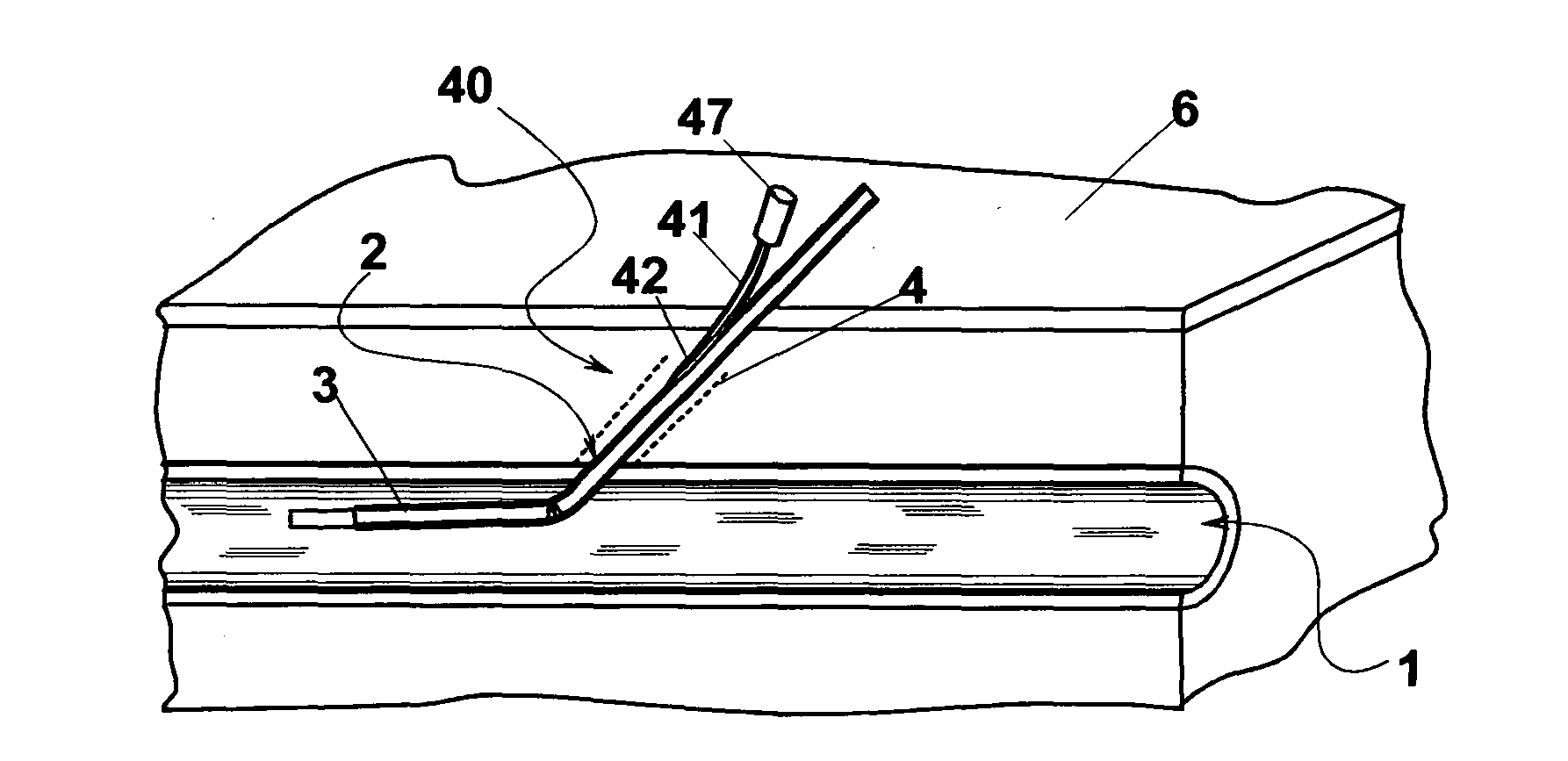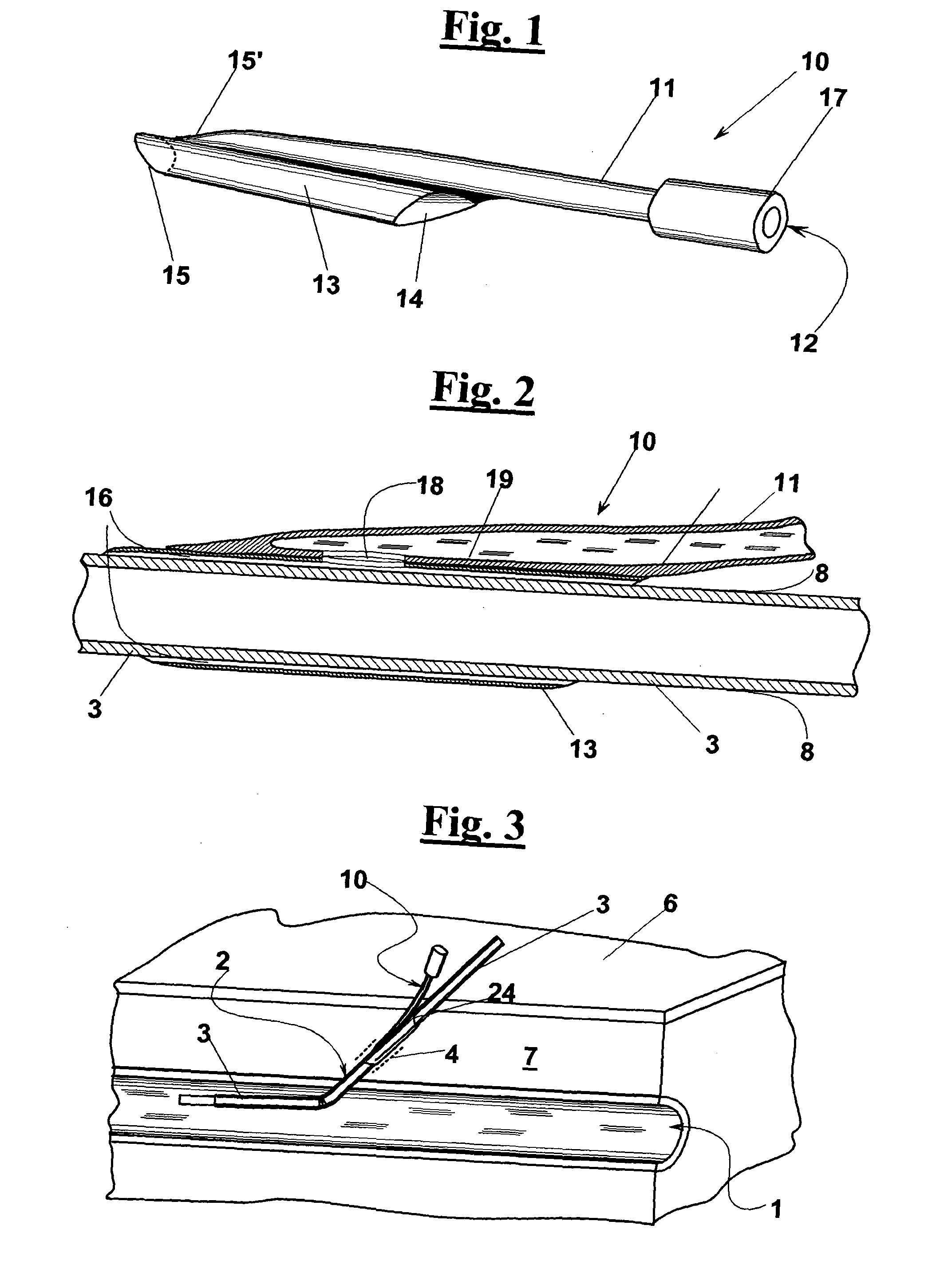In some cases, even by prolonging the compression the
entry site cannot be closed, and a
surgical treatment is necessary, which may involve further risks, discomfort, prolonged period in
bed and resources waste.
Furthermore, in case of obese patients, the adipose layer that is located between the
skin and the vascular
entry site reduces the efficiency of the compression.
Moreover, an
entry site on a
vascular prosthesis that is made of plastic (Dacron, PTFE, etc.) cannot heal by the natural
repair processes of an
artery, and, on the contrary, it can only be closed by formation of a true plug made of blood that, after flowing out of the opening, coagulates through the tissues that surround the
prosthesis, under the assistance of the compression force.
Furthermore, the mechanical closure devices require a
highly skilled operator, and / or the work of further assistant operators.
Therefore, these techniques do not provide a valid alternative to the traditional techniques.
Systems are also known for closing the entry site of an introducer sheath with exclusive use of a haemostatic liquid, in particular collagen, to form clots that are involved in a natural coagulation mechanisms; however, the haemostasis process is slow, and complications may arise such as blood suffusion, bleeding, pseudoaneurysms.
it is very difficult to release a quick setting haemostatic liquid in a pure state in an operation region where blood under pressure is present.
The methods that use quick setting surgical glues provide a
dilution of the glue, but this prolongs the hardening time;
with well known techniques, and also under echographic control, it is difficult to release such pure quick setting haemostatic liquid
proximate to a vascular entry site without the risk of injecting it into the
blood vessel, with such complications as
thrombosis or embolisms.
The echographic control may not be always available when this kind of intervention is performed, because it requires experienced operators and in any case it requires more than one operator for closing the entry site.
This causes an unsteady positioning of the introducer sheath, which is particularly critical in the case of obese patients, where the distance between the
skin and the
blood vessel is higher that in normal patients.
Furthermore, the large transversal size of the device hinders the movement through the tissues, and “digs” an enlarged space about the introducer sheath in which both the released haemostatic liquid and the blood can accumulate without contributing to the entry site
occlusion.
In any case, the device is not adapted to treat a quick setting liquid, because the delivery mouth may be easily clogged.
In particular the device of US2008 / 45700 is adapted to treat bleeding diseases, for example, in the
stomach and in the intestine, but it cannot be used neither for an endovascular intervention, nor for closing an arterial entry site.
Due to its high reactivity, a
cyanoacrylate material would immediately polymerize when brought into contact with the blood, which would reduce the passage through the
catheter, or even clog it, in such a way that the release of a significant amount of surgical glue would be impossible.
This is a rough method, by which the risk may arise of injecting the procoagulating substance into the vessel; for the same reason, the method and the apparatus cannot be used to safely release surgical glues, which are not cited in the
patent application.
Furthermore, the document does not provide precise indications about the way the liquid is supplied at the entry site.
In any case, the device cannot be used to release a quick setting surgical glue
proximate to an entry site, because the glue would come into contact too early with the nearby
biological fluids which would block the device; furthermore, it does not allow an operator to determine the point of delivery, unless an echographic control is provided.
Similarly to any well-known
syringe, a similar device does not allow providing a quick setting. in particular of a haemostatic liquid in a pure state, at an entry site or in an is operation region of an
endovascular surgery.
Concerning the
endovascular surgery, such as an
embolization of arterial or venous districts, or the treatment of arterial walls dissections, the problem often arises of covering a long distance between the entry site, which is normally made in the
artery of the arm or in the
femoral artery, and the operation region.
When the use is desirable of a pure quick setting surgical glue, which would have a
maximum efficiency and application speed, the problem arises of conveying the glue through a long duct, and of preventing at the same time any risks of contact between the glue and the blood until the remote vascular district is reached where the intervention must be made.
 Login to View More
Login to View More  Login to View More
Login to View More 


